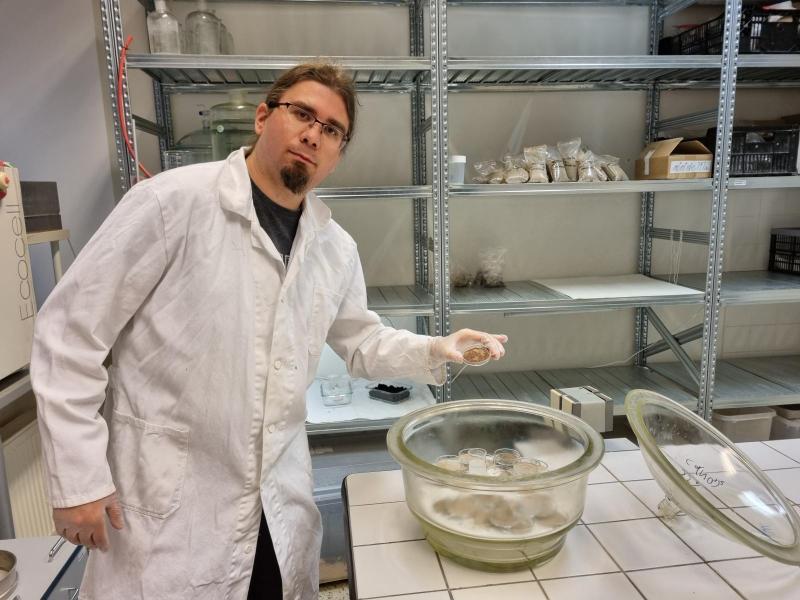Ideas and discoveries
Experiment from FCH BUT shows that bioplastics are not always the greener choice

“Bioplastics are not a miracle material that will save the environment,” explains Jakub Fojt, a doctoral student from FCH (Faculty of Chemistry) BUT (Brno University of Technology). “We have to learn how to use them properly so they don't bring more negatives than positives.” A series of laboratory experiments in which researchers have compared the effect of biodegradable microplastics and conventional PET microplastics on soil properties are intended to contribute to this.
The increasing amount of microplastics in the environment is leading to efforts to replace conventional plastics with biodegradable ones. However, their use may not always be beneficial, according to research from FCH BUT.
“We tested the effects of a particular type of bioplastic – poly-3-hydroxybutyrate (P3HB) on soil properties. It is a biodegradable plastic that can also be made from used frying or coffee oil. Biodegradation should completely decompose the material through the action of the right bacteria. However, it turned out that under inappropriate conditions, biodegradation is very slow or does not occur at all,” explains Jakub Fojt, a doctoral student.
“For complete biodegradation to occur, the bioplastic product must be ground into the smallest possible particles and placed in an aggressive environment – for example, in compost, where temperatures rise to 70 °C. However, whole bioplastic cups dumped in the sea or in the woods will definitely not degrade within a few years because the environment is not aggressive enough. This will lead to decomposition or biofragmentation,” adds Fojt.
Experiments from FCH BUT then showed what effect of contamination with P3HB bioplastic, which degraded to microparticles, can have on soil properties. In the first experiment, the scientists investigated the effect on the abiotic properties of the soil. There is a hypothesis that particles of common microplastics can block pores and cause soil drying. In this case, microplastics had the same effect on soil drying as standard microplastics.
The second experiment revealed even more significant findings. “It has been shown that increased concentrations of microplastics in soil can lead to increased fungal growth, again compared to standard microplastics. Biodegradation of plastics can also lead to nutrient depletion – specifically nitrogen, which is scarce in the soil. It has affected the harvest very dramatically. The soil containing the most bioplastic had 80% lower yields than the soil without contamination,” says Fojt.
The third experiment was about the effect of microbioplastics on soil animals. “We have observed minor variations in the birth rate of earthworms. This suggests that the microbioplastic could induce stress in them, but we need further experiments to confirm this,” explains the doctoral student.
According to him, bioplastics are suitable if they are used in the right areas and processed in the right way. “I don't see much added value in making biodegradable cups or cutlery. They cannot be recycled and composting community does not like to see them in their unground form. Most of them end up in a landfill or incinerator anyway,” Fojt tries to point out.
Cups and cutlery labelled as bioplastic can confuse users who sometimes incorrectly classify them as plastic waste in yellow containers. “It is a new material that is very sensitive to higher temperatures. If it gets hot, it will start to break down into monomers or burn. It can contaminate thousands of properly sorted PET bottles,” adds Fojt, explaining that bioplastics are nowadays best thrown into mixed municipal waste.
On the other hand, he sees the potential of bioplastics in replacing conventional microplastics in cosmetics, where they act as abrasives in toothpastes or peeling products. “The particles of such biodegradable plastics are very small and after use they go directly to the wastewater treatment plant, where the environment is very aggressive. The complete biodegradation should therefore take place without any problems,” he explains.
According to Fojt, bioplastics are also beginning to be used in the agricultural industry, where they are used as fertiliser carriers or mulch films. Currently, mulch films are mainly made of conventional plastic and farmers should remove them from the field after harvest. “The problem may arise if the film is labelled as biodegradable, the farmer could plough it into the soil. Without knowing that this increases the concentration of microbioplastics and, without proper care, deteriorates the soil properties,” he adds.
According to him, the most important thing when dealing with biodegradable plastics is education – otherwise, as the findings so far suggest, they may do more harm than good. Jakub Fojt wants to use the results of the experiments for further research in real conditions and at the same time open a public debate about the limits of bioplastics and proper treatment. “It's certainly not a miracle material that will allow people to continue to be environmentally irresponsible and throw cups in the woods or dump waste in the oceans.“
Cheaper, better quality and eco-friendly. FCH BUT researchers create new dextrin adhesive
From uncertain beginnings in chemistry to a prestigious award. A young scientist from FCH BUT won the Czech Head Award for her research into unusual forms of DNA
Research from FCH BUT has contributed to a better understanding of cement-free concrete. The finding were also published in prestigious journals
Stevan Gavranović studies environmentally friendly lead-free halide perovskites
Recycling solar panels? No yet existent. NEW technology from BUT offers a solution